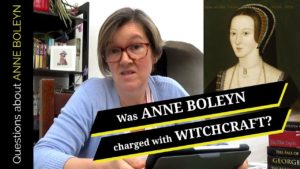 The latest instalment in my video series “Questions about Anne Boleyn” looks at the question “Was Anne Boleyn charged with witchcraft?” something that rears its ugly head every May when I talk about the indictments of charges laid against her, Anne’s trial and her execution.
The latest instalment in my video series “Questions about Anne Boleyn” looks at the question “Was Anne Boleyn charged with witchcraft?” something that rears its ugly head every May when I talk about the indictments of charges laid against her, Anne’s trial and her execution.
Did the charges against Anne Boleyn include witchcraft?
What about the deformed foetus and extra finger? Were they used a proof of her being a witch?
Did Henry VIII believe that Anne Boleyn had bewitched him?
And what about the men? Were they involved in witchcraft?
I examine this topic in my latest video.
I do hope you enjoy it and please do share your thoughts and opinions.